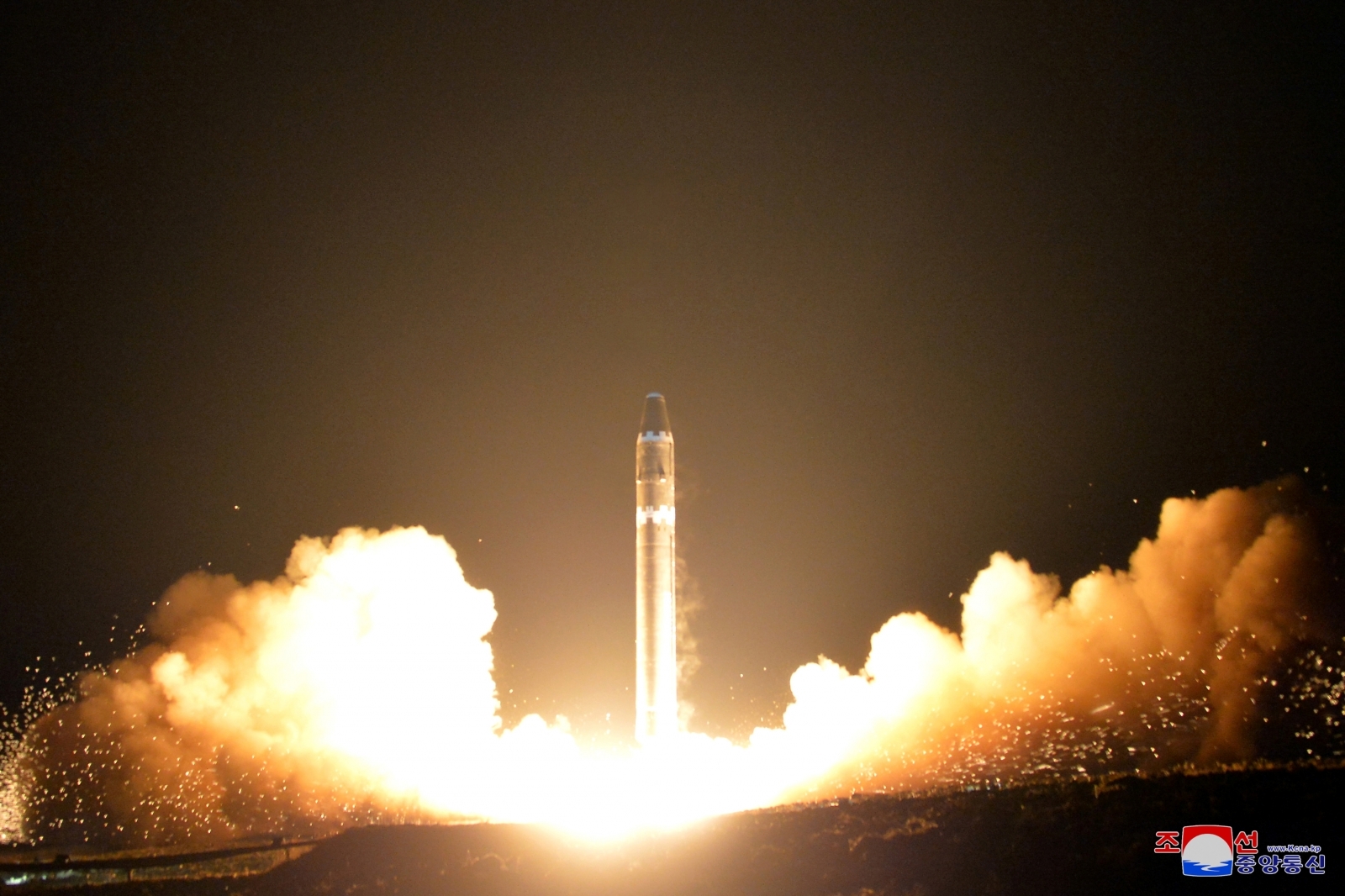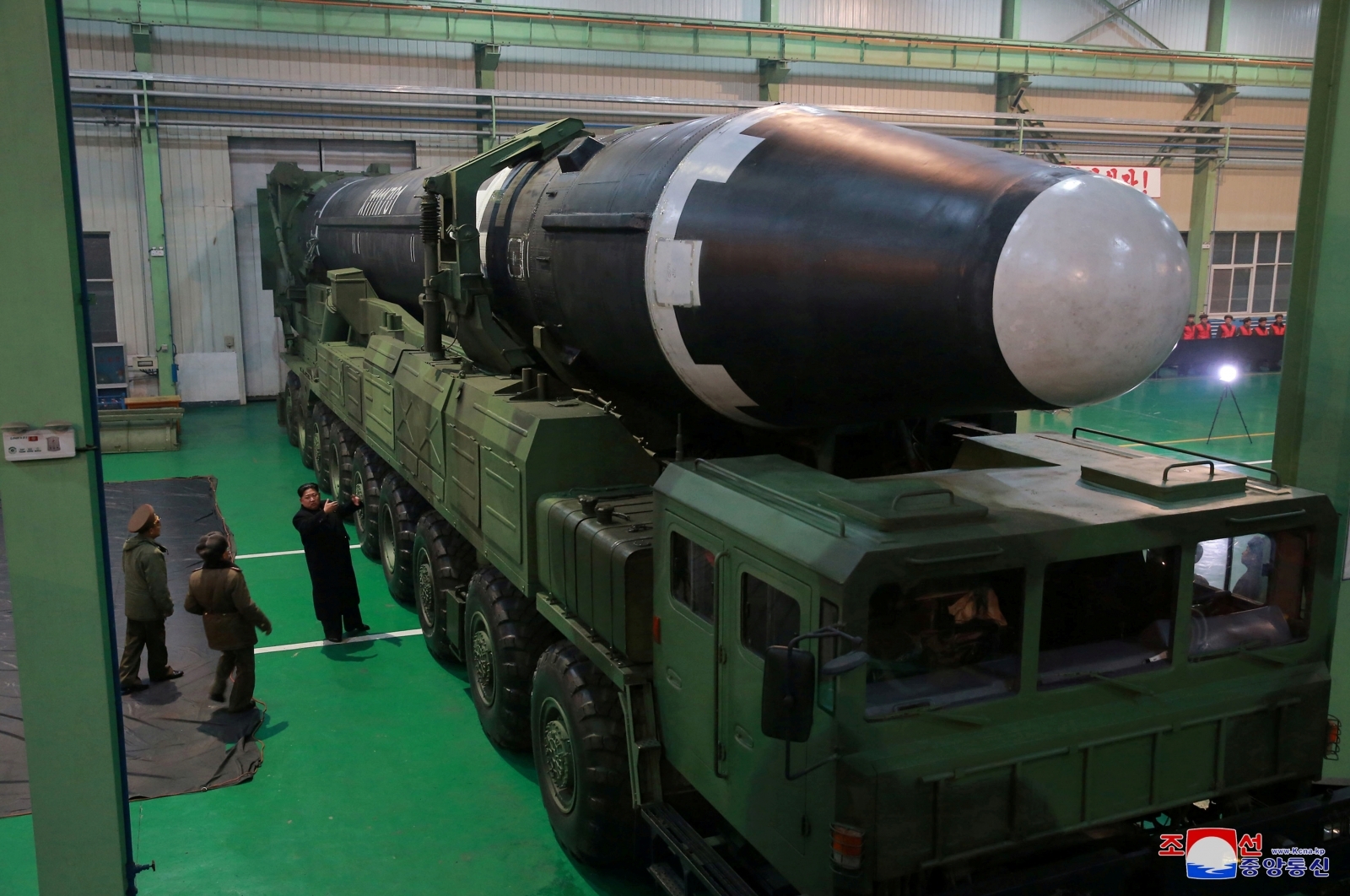New North Korea ICBM photos show Kim Jong-un celebrating but is the giant missile nuclear capable?
Newly-released photos of North Korea's latest missile launch showcase the massive ICBM – Hwasong-15.
North Korea recently launched its new, massive ICBM (intercontinental ballistic missile) Hwasong-15. Newly-released photos of the last missile launch show a massive nose cone, hinting that the missile may indeed have nuclear warhead capabilities – a claim that Pyongyang previously boasted about, shortly after the missile landed in Japanese waters.
Some of the photos show the reclusive nation's self-proclaimed supreme leader Kim Jong-un inspecting the giant Hwasong-15 missile, while others appear to show Kim celebrating the successful launch. In an official statement, Pyongyang said that Hwasong-15 was "the most powerful" missile it had fired till date, adding that the missile was tipped with a "super-large heavy nuclear warhead" capable of striking the entire US mainland.
The photos appear to indicate that the Hwasong-15 is much larger and wider than its predecessor Hwasong-14, which Pyongyang launched twice in July.
However, despite the Hwasong-15's massive size, experts are still reportedly speculating about whether the missile would be able to carry a heavy nuclear warhead and still successfully reach mainland US.
"North Korea could be able to mount a nuclear weapon on a missile, but that warhead still has to go into space and successful come back down into the atmosphere to its target," Strategic Sentinel CEO Ryan Barenklau told IBTimes UK.
"This process generates heat up to 3,000C, an insane amount of friction is produced. This is why most meteors burn up in the atmosphere. So far no conclusive evidence has been produced to accurately say what progress has been made by North Korea on their RV [Re-entry Vehicle]. I am assuming North Korea will be wanting to test their RVs with the upcoming tests of the HS-12, 14, and 15."
"My best estimate of the current size of North Korean weapons is somewhere between too big and primitive miniaturization. They have not conducted enough nuclear tests in my opinion to really prove their designs when it comes to miniaturization," Barenkalu added.
"This isn't just a big missile for North Korea this is a big missile in general," Michael Duitsman, a research associate at the James Martin Center for Nonproliferation Studies (CNS), told CNN. "There are not a lot of countries who could build a missile this big and have it work."
According to David Schmerler, another research associate with the CNS, the pictures alone do not offer conclusive evidence of whether the Hwasong-15 is capable of carrying a nuclear warhead, CNN reported. Schmerler reportedly cautioned that Pyongyang's claims should be taken seriously, adding that the missile test was likely conducted using a decoy warhead that weighed the same as a nuclear bomb.





"They're going to try to maximize the amount of (information) you can get out of each test," Schmerler told CNN. "They're not going to launch something for the sake of it, it makes much more sense for them to try and field a realistic decoy payload."
North Korea's latest missile also reportedly uses two engines and no supplementary thrusters, as compared to the Hwasong-14, which used one primary engine and four steering thrusters. "This is certainly a big adjustment," Schmerler reportedly said. "It means they've probably gimbaled the engines ... something we've never seen the North Koreans do."
The recently-released photos were also tweeted out by Strategic Sentinel, a Washington D.C.-based nonpartisan geostrategic consulting agency, which wrote in a post: "If the Titan-2 and the DF-41 had a baby this may be what it would look like."
If the Titan-2 and the DF-41 had a baby this may be what it would look like...
— Strategic Sentinel (@StratSentinel) November 29, 2017
CNN reported that the Titan-2 was the heaviest and biggest nuclear missile developed by the US during the Cold War and was capable of carrying a 9-megaton nuclear warhead 15,000 kilometers, with a blast yield 600 times that of the nuke dropped on Hiroshima.
The DF-41 is China's latest next-gen ICBM - the country's very first multiple nuclear warhead-carrying missile. The missile, which was recently reportedly reached the final stages of development and is expected to be mission-ready by 2018. Yang Chengjun, a missile expert recently told China Central Television that the DF-41 "can cover every corner of the globe".
The missile reportedly has a range of over 12,000 Kms, weighs around 60 tonnes and functions on use of three solid fuel propulsion. It can reportedly carry between 6 and 10 nuclear warheads simultaneously, making any interception and defence against attacks highly challenging.
Some experts reportedly suspect that Pyongyang may already be prepping for yet another missile test, given how in July, two tests of the Hwasong-14 were conducted within a span of weeks.
"I think this HS-15 is the most technologically advanced missile North Korea has ever produced and successfully fired. I think North Korea is still a ways away from being able to launch a nuclear warhead outside of their sphere of influence, but they are making fast progress towards that goal. They have a lot of testing of both their delivery systems and nuclear weapons yet to come I would think," Barenklau told us.
Experts at the US-based think tank 38North said in a recent blog that "two or three test firings over the next four to six months may be all that is required before Kim Jong Un declares the Hwasong-15 combat ready".






Update:-
This article has been updated to include the comments of Strategic Sentinel CEO Ryan Barenklau.






















